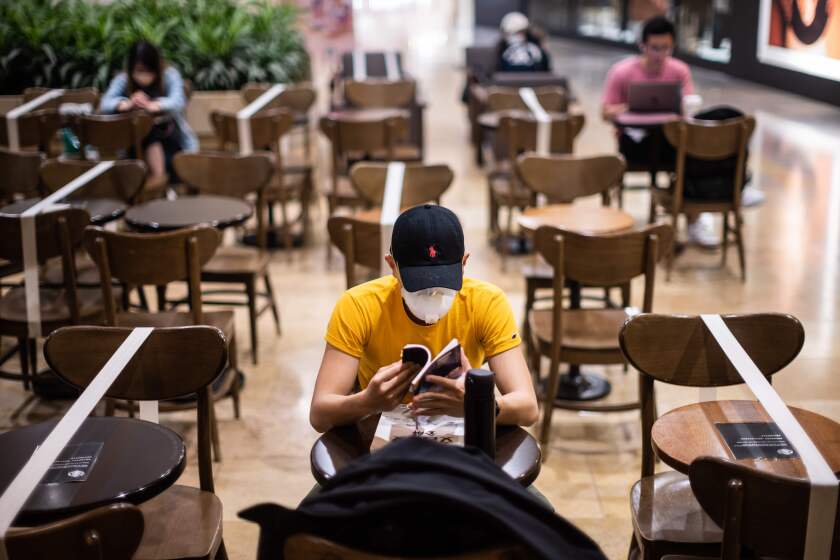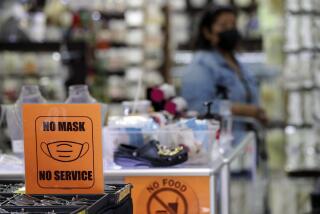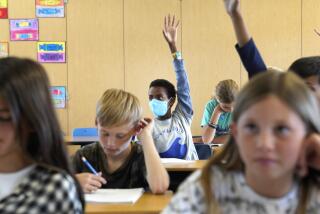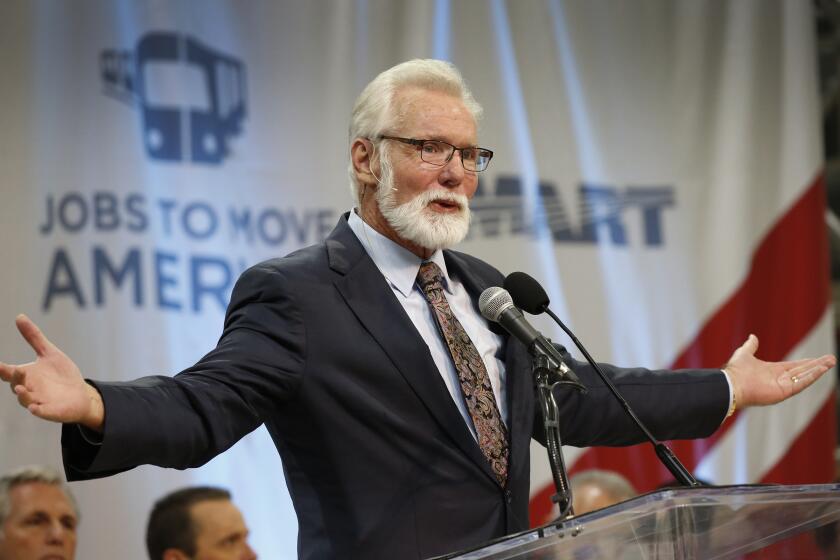California’s coronavirus curve: Fewer deaths but a longer stay-at-home requirement
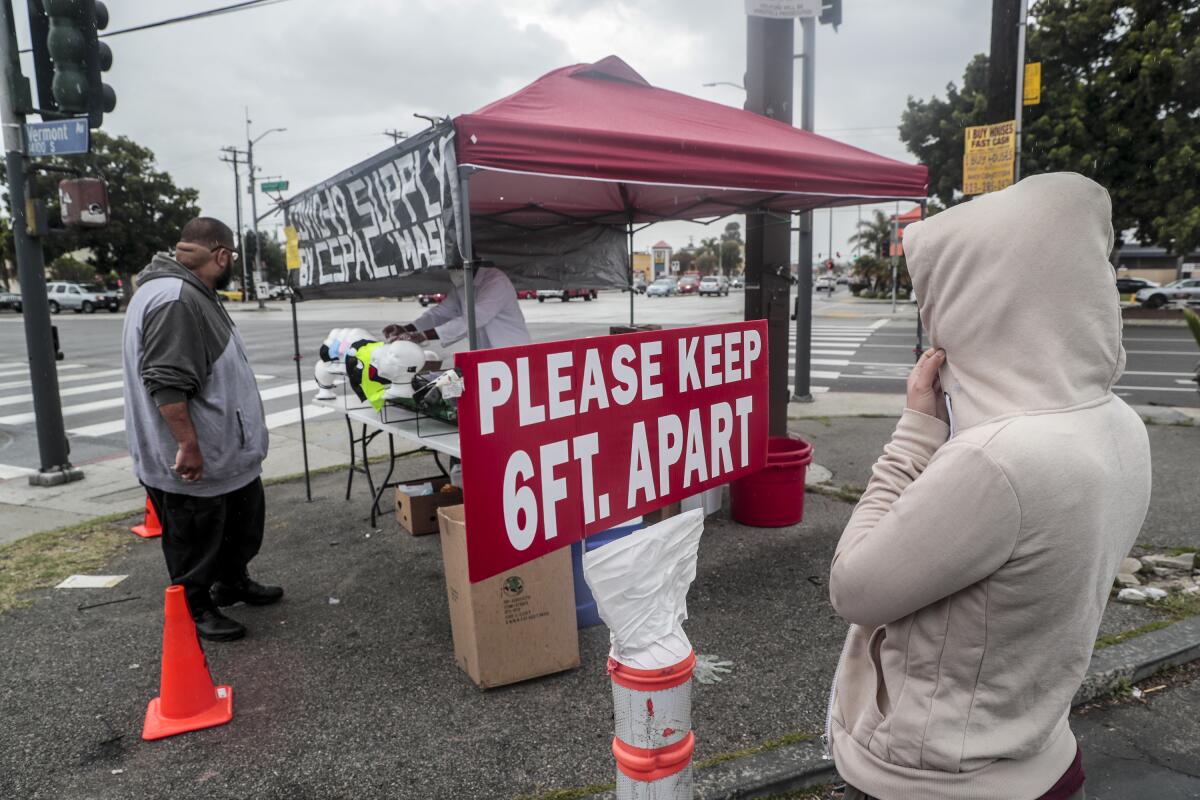
- Share via
SAN FRANCISCO — California is beginning to see guarded progress in its fight against the coronavirus, with a slower spread in infections and the number of deaths — while rising rapidly — lagging significantly behind hot spots like New York and Italy.
But California’s early successes are unlikely to bring a rapid return to normal life.
Health officials say weeks and probably months of major restriction on movements and large gatherings are the only ways to prevent coronavirus cases from surging to unmanageable levels.
Dr. Robert Kim-Farley, medical epidemiologist and infectious diseases expert at the UCLA Fielding School of Public Health, said the flatter curve in new coronavirus cases likely means far fewer deaths than experts once feared, because hospitals won’t be overwhelmed by patients and have to ration care. But keeping it that way also means an extended period of social distancing.
“Yes, it can mean that it stretches out longer, but that is a better price to pay than with unnecessary death,” he said. “We are really buying for ourselves the reduced peak. And that is a thing that will save us from a lot of unnecessary deaths because of an overloaded healthcare system.”
Even this comes at the steep price.
The stay-at-home orders are ravaging the economy, leading to massive unemployment as many businesses have shuttered. But lifting the restrictions poses major health risks, and officials warn to expect another wave of cases as social distancing is eased.
“There will definitely be individuals who will get sick. And because there are individuals who get sick, there will be individuals who die after the order is released, unless we come up with a foolproof immunization, which is highly unlikely,” said Dr. Jeffrey Smith, Santa Clara County executive officer this week.
Smith, whose county hosts the venues where the San Francisco 49ers and San Jose Sharks play, said he did not expect there would be “any sports games until at least Thanksgiving, and we’d be lucky to have them by Thanksgiving. This is not something that’s going to be easy to do.”
The Bay Area’s stay-at-home orders have been extended to early May, but the mayor of San Francisco, London Breed, has suggested a shelter-in-place mandate could remain in place longer.
California’s public schools are unlikely to reopen the remainder of the academic year. San Francisco’s LGBT Pride Parade and Celebration in late June likely won’t be held without major changes, the mayor said Wednesday. L.A. Pride in June has already been postponed.
Dr. Anthony Fauci, director of the National Institute of Allergy and Infectious Diseases, also offered sobering predictions about the new normal, noting it’s unlikely the new coronavirus will ever be completely eradicated. There will be a gradual process by which society can begin to function again, but “if you want to get to pre-coronavirus, that might not ever happen in the sense of the fact that the threat is there.”
Gov. Gavin Newsom said Wednesday that the duration of the coronavirus stay-at-home order is dependent on whether Californians continue to follow it and wear appropriate face coverings if they go out.
Coronavirus: When will California stay-at-home end? Newsom says a team is working on timing
The governor said the state plans to expand testing, including serology tests and community surveillance testing, to better understand when “we get back to a new normalcy.”
“We have a team of people working on this 24/7,” Newsom said. “There’s no question on this that we haven’t asked ourselves on dozens and dozens of occasions. Everybody, not least of which myself as governor of the state of California, wants us to be able to affirmatively answer that question by giving you a specific date and time and in detail telling you how people are going to go back to work, back into their community.”
The Santa Clara County public health officer, Dr. Sara Cody, said four things need to happen for stay-at-home orders to be eased: Robust hospital capacity; the ability to test for the virus broadly; the ability to rapidly investigate new cases, isolate the infected and identify those who may have been exposed and quarantine them to see if they get sick; and a sustained reduction in new coronavirus cases.
Once California gets through its stay-at-home phase, there might be a gradual rolling back of restrictions. “We’re not going to back off all the way; we’re going to back off a little bit,” suggested Dr. George Rutherford, a UC San Francisco epidemiologist and infectious diseases expert.
Possible ideas include keeping schools closed, suggesting masks be worn outdoors, extending a ban on mass gatherings and keeping older people sheltered in place, Rutherford said. Perhaps only a fraction of people — or only certain industries — might return to their physical workplaces initially.
These are some of the unusual new scenes across the Southland during the coronavirus outbreak.
Dr. Howard Markel, a professor of the history of medicine at the University of Michigan, said deploying stay-at-home measures requires a degree of patience not to pull back too early.
“If you pull the triggers off too early, not only is there a circulating virus to do what it naturally does, but you will have incurred all the economic and social disruptions of [stay-at-home orders] for nothing,” Markel said in a webinar hosted by the American Public Health Assn. last month.
Markel said that during the 1918 flu pandemic, more than 20 U.S. cities that relaxed physical distancing orders too quickly — even as the flu virus was still circulating — soon saw a new rise in cases.
Some say that periods of social distancing may need to continue over the next two years.
A mathematical model developed by researchers at the Harvard T.H. Chan School of Public Health suggested that a one-time effort at social distancing, as the U.S. is undertaking this spring, wouldn’t be enough to keep coronavirus case levels low enough to prevent hospital systems from being overwhelmed.
If it’s true that the coronavirus can spread more easily in the fall and winter, there could be a resurgence of infections later this year.
As a result, we might need long periods of social distancing, “perhaps with occasional periods of loosening,” to keep only a fraction of the population infected with the coronavirus at any one time. Under one plausible scenario, social distancing measures could be fully relaxed by early to mid-2021, with the epidemic concluding by July 2022, Harvard researchers said. At that point, the coronavirus is anticipated to circulate seasonally, peaking in the winter.
Travelers importing the coronavirus into areas thought to have had early successes against the disease can pose a problem.
Singapore, which took early, effective action against the coronavirus, was forced last week to order the closure of schools and nonessential businesses for a month. The numbers of coronavirus cases rose as residents who lived and studied abroad rushed back home.
Officials in Singapore now say it is important to find sustainable ways to slow the virus through the end of the year.
After appearing to have the virus under control, Singapore, Vietnam and Hong Kong are imposing new controls as COVID-19 infections continue to rise.
Authorities there began to believe that people weren’t taking the pandemic seriously enough, with one official, Lawrence Wong, co-chair of Singapore’s coronavirus task force, lamenting that some Singaporeans were still asking whether they could go to malls or have parties of fewer than 10 people, requests were “missing the point” of the need for social distancing.
“With the second wave, we are finding it a lot harder to control local spread as well as stop imported cases,” said Paul Ananth Tambyah, Singapore-based president of the Asia Pacific Society of Clinical Microbiology and Infection. “That is something that all countries will probably eventually discover.”
Some experts say the idea of being forced to choose between the economy and public health is a false choice. “You can’t sacrifice the population for the economy, because ultimately that’s going to kill the economy as well if you have healthcare systems overwhelmed,” UCLA’s Kim-Farley said.
Lin reported from San Francisco, Luna from Sacramento. Times staff writer Shashank Bengali contributed to this report from Singapore.
More to Read
Sign up for Essential California
The most important California stories and recommendations in your inbox every morning.
You may occasionally receive promotional content from the Los Angeles Times.


